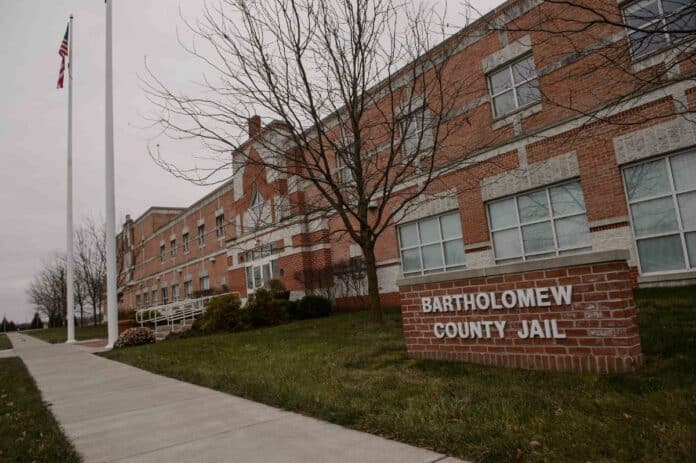Indiana’s recent criminal justice reforms are contributing to overcrowding and rising costs at county jails across the state, including Bartholomew County, jail officials said.
A recent surge in the number of inmates housed in local county jails mirrors a statewide trend that is due, in part, to the state’s criminal justice reform efforts over the past few years, when the number of felony classes and mandated that certain low-level felons be sent to county jails instead of state prisons.
The shift has left many county jails struggling to make room for the influx of inmates and keep up with the costs of housing them.
“(The county jail population) just keeps going up,” said Maj. John Martoccia, Bartholomew County Jail commander. “It’s been a struggle. I think any jail would tell you that. Most of the (county) jails are overcrowded.”
[sc:text-divider text-divider-title=”Story continues below gallery” ]
In January 2016, the Bartholomew County Jail had a daily average of 157 inmates, jail statistics show. By August 2017, that number had jumped to 235. In February, the jail population reached 266 — the highest in the jail’s history.
As of March 8, there were 239 inmates in the Bartholomew County Jail, in a facility that currently has 232 beds. The extra inmates sleep in moveable plastic bunks in the common area of the cell block, Martoccia said.
Currently, Bartholomew County is housing 42 inmates who are Level 6 felons serving their sentences, which is approximately 18 percent of the jail’s overall population, Martoccia said.
Two years ago, Bartholomew County introduced a new procedure as part of the county’s participation in the National Evidence-Based Decision Making Initiative, a federal program that encourages counties to re-evaluate processes in the criminal justice system. Bartholomew County is one of six counties participating in the effort.
Among the changes already made was revamping the current pre-trial diversion process, which includes a risk assessment to be given after an individual is arrested in Bartholomew County. That assessment determines which offenders could be released from the Bartholomew County Jail on their own recognizance after their arrest rather than being required to bond out of jail, which could, at times, help lower the number of people held at the jail.
On average, one or two people who have been arrested are immediately released if they qualify under the rules of the diversion process, instead of being held at the jail until they can post bond.
Jackson County, for its part, has seen a similar rise in its jail population, said Chris Everhart, Jackson County Jail commander. Everhart said that taking on Level 6 felons has “significantly” increased the number of inmates.
“Last summer, we got up really close to the 300 mark, and we had to ship inmates to (Perry County),” he said. “I don’t think that had been done before, and I’ve been here almost 20 years.”
Currently, the jail, which is in Brownstown, has 26 inmates who have been sentenced for a Level 6 felony. However, many more inmates — upwards of 65 percent of the overall jail population — have been charged with a Level 6 offense and are awaiting trial, he said.
In February 2018, Jackson County commissioners voted 3-0 to close the county’s juvenile detention center in order to expand the county jail’s capacity to house adult inmates. Sgt. Josh Clark of the Jackson County Jail said the uptick in Level 6 offenders “helped swing the decision.” Currently, the former juvenile detention center holds all of Jackson County’s female inmates, while the juveniles are now sent to Bartholomew County’s Youth Services Center.
Statehouse fallout
Local jail officials say the overcrowding issues stem from efforts by state lawmakers to overhaul the state’s criminal code in recent years.
In 2013, the Indiana General Assembly passed House Enrolled Act 1006, authored by Rep. Greg Steuerwald (R-Avon), which expanded the felony classes in the state’s criminal code into six categories, called levels, and placed murder in its own crime class. Gov. Mike Pence signed the bill into law in May 6, 2013, and it went into effect on July 1, 2014.
In 2015, the Indiana General Assembly passed a separate House Enrolled Act 1006, which mandated, among other things, that the lowest-level felons, Level 6, be housed in county jails instead of the state’s overcrowded prison system. At the time, it was championed as a first-of-its-kind attempt at reducing recidivism by focusing on treating drug addiction and mental illness, which are two of the main underlying causes of Level 6 felonies, according to state lawmakers.
While the overall U.S. prison population fell in 2017, Indiana became the first state in the previous 15 years to see its jail population shoot up 32 percent or more over a two-year period (2016-17), according to the Vera Institute, an independent research institute that analyzes the U.S. criminal justice system. Additionally, the institute reported that 64 of Indiana’s 92 county jails are overcrowded. The increase happened just after Pence signed the 2015 bill into law, according to the institute.
The number of Level 6 felonies has been largely driven by drug-related offenses, according to jail officials and state legislators.
Nearly one in four felonies committed in the state in 2017 were Level 6 offenses, according to data from the Indiana Department of Corrections. Receiving stolen property, possession of methamphetamine and possession of syringes and needles were the most common Level 6 felony convictions in 2017, according to state statistics.
Rates of reimbursement
Under the current rules, the Indiana Department of Corrections reimburses county jails $35 per day for each Level 6 inmate the local jail houses.
Several sheriffs around the state, among them Porter County Sheriff David Reynolds and Vanderburgh County Sheriff Dave Wedding, have questioned the state’s decision to continue to mandate that counties house Level 6 felons without adequate reimbursement.
Reynolds, speaking at a legislative committee hearing alongside his colleagues in the Indiana Sheriffs Association, said the state must address jail overcrowding and related issues on a case-by-case basis if lawmakers want to ensure long-lasting change.
The sheriff’s association argued at the legislative hearing that the reimbursement rate has not been changed in decades and does not come close to covering the costs of housing, feeding and providing medical care to an inmate.
George Angelone, executive director of the state’s Legislative Services Agency, said the earliest record the agency has of a $35 reimbursement rate is in the 1991 state budget.
Martoccia said it costs around $79 per day for the Bartholomew County Jail to house a Level 6 felon. Using that figure as an estimate, Martoccia said the jail spent roughly $1.15 million last year housing Level 6 felons — 2.5 times more than what the county will get back from the state.
Martoccia said he has to find a way to squeeze the difference out of the jail’s budget, which was $3.6 million in 2018. He said he is “constantly trying to save money here and there,” including attempting to cut costs on clothing and other supplies for the inmates.
So far, Bartholomew County has received $429,415 in reimbursements for housing Level 6 inmates last year, though Martoccia said he expects that figure to jump to approximately $511,000.
“There’s still money coming in for 2018,” he said. “The county’s just not received it yet.”
So far, little help has come from the Statehouse as efforts by state lawmakers to significantly raise the reimbursement rate this session have fizzled out.
Senate Bill 120, authored by Sen. James Tomes (R-Indianapolis), would have raised the rate to $55 per day, but it failed to make it out of committee before the Feb. 21 deadline, said Ryan Kommes, Tomes’ press secretary.
House Bill 1622, which also would have raised the rate to $55 per day and allowed county jails to send violent or disruptive Level 6 felons back to state facilities, will meet a similar fate, according to Rep. Ryan Lauer (R-Columbus), the bill’s author.
Lauer said the $55 came from a study by a Indiana Sheriff’s Association that found that $55 is the average cost across the state of housing a Level 6 offender.
“It’s clear that $35 is not adequate for the actual cost of housing Level 6 felons,” Lauer said. “I’m just looking for the state to contribute the dollars so that we are not losing dollars for each Level 6 felon that were housing in our county jails.”
Lauer said he and his colleagues were able to slip a modest increase into the state’s budget bill for the Level 6 felon expenses. According to the current language of the bill, the rate would be raised to $37.50 per day in fiscal year 2020 and $40 per day in fiscal year 2021. The house passed the bill 65-33 on Feb. 25. It is pending in the state Senate.
“I’m very encouraged that we’re going in the right direction,” he said.
[sc:pullout-title pullout-title=”About the law” ][sc:pullout-text-begin]
In 2015, the Indiana General Assembly passed House Enrolled Act 1006, which mandated, among other things, that the lowest-level felons, Level 6, be housed in county jails instead of the state’s overcrowded prison system.
At the time, it was championed as a first-of-its-kind attempt at reducing recidivism by focusing on treating drug addiction and mental illness, which are two of the main underlying causes of Level 6 felonies, according to state lawmakers.
The Indiana Department of Correction’s population stands at 46,903 people, including Level 6 felons in county jails and community programs. This represents an 11 percent increase in growth experience from 2015 to 2018, said David Powell, executive director of the Indiana Prosecuting Attorneys Council, while testifying at a legislative committee hearing.
Four Indiana counties are building new lockups in response to jail overcrowding, Powell said. An additional 32 counties are also considering proposals to construct new jails. Conservative estimates project the statewide cost at $1.5 billion, according to the Indiana Sheriffs Association, or an average of $30 million spent per county.
[sc:pullout-text-end][sc:pullout-title pullout-title=”Where to learn more” ][sc:pullout-text-begin]
To follow bills still alive at the Statehouse during this legislative session, visit:
iga.in.gov/legislative/2019/bills/
[sc:pullout-text-end][sc:pullout-title pullout-title=”Next Third House” ][sc:pullout-text-begin]
To learn more about local state legislators’ positions on pending bills, plan on attending the next Third House.
It will be from 7:30 to 8:30 a.m. March 25 at Columbus City Hall, with a location change to the City Council chambers on the second floor.
For more information, visit the Columbus Area Chamber of Commerce website at columbusareachamber.com.
[sc:pullout-text-end]





